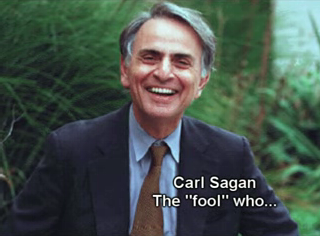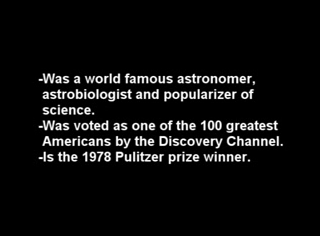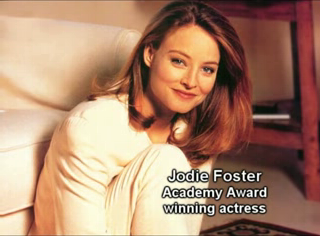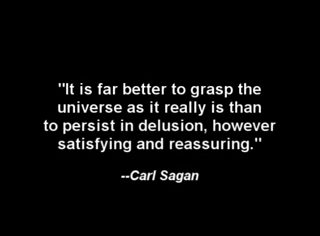Later this month, on December 20, 2007, we will reach the eleventh anniversary of Carl Sagan's passing — and the first anniversary of the wildly successful first-ever Carl Sagan Memorial Blog-a-Thon. Far exceeding my wildest expectations, this became a truly worldwide celebration, with more than 250 posts in 11 languages. And for those who like nice round anniversary numbers, this year also saw quite a number of significant Sagan-related ones: the tenth anniversary of the release of the film Contact and the Planet Walk in Ithaca, NY; and the thirtieth anniversary of the launch of the two Voyager spacecraft. I am launching a new blog-a-thon exactly a year after the first one; for full details, see the main announcement post on my personal blog. See you on the 20th!
Help Us Remember
12.05.2007
Announcing the second annual Carl Sagan memorial blog-a-thon
Arthur C. Clarke 90th birthday blog
Since Clarke will be turning 90 this month, Heenatigala was inspired by my Sagan blog-a-thon to create a blog to celebrate Clarke's 90th birthday. December 16th is the special date! He is sending an open invitation to all Clarke fans to post birthday wishes as blog comments.
11.17.2007
"Atheist" video by Zachary Kroger
This five-minute video in "defense of atheists" has been a hit on YouTube since its debut in mid-2006 (with more than 800,000 views and 80,000 comments, and praise from the likes of James Randi, Michael Shermer, and Penn & Teller), but has gotten extra attention from a mention in the article "God and Man on YouTube" in last week's New York Times Magazine.
Much of the video (a "video response" to icecorescientist's Pale Blue Dot video) features slides of famous people who many might not realize are atheists (similar to lists on websites like this one); and sure enough, Carl Sagan is featured:


The star of Contact also appears:

And at the end, this quote is featured:

10.04.2007
Sagan and the Dalai Lama, a Retrospective.
Religion and science do not have to be at odds. Science, said Ann Druyan, widow of Cornell astronomer Carl Sagan, can communicate with, learn from and even benefit from religion and vice versa.Click here to read the whole article from Cornell University's Chronicle Online.Druyan, a writer and media producer who collaborated with Sagan for 19 years until his death in 1996, reflected on dialogues in the early 1990s between Sagan and the Dalai Lama at a Sept. 28 lecture in Anabel Taylor Auditorium. For the first time, film excerpts of the meeting between the two were shown in a public venue.
Sagan, Cornell professor and author of "Cosmos," "Contact" and "Dragons of Eden," among other books, was perhaps best known for his extraordinary ability to communicate science to the public. "He wanted to share with everyone the wonder and awe that science inspired in him," Druyan said.
She stressed that there were political motivations behind Sagan's work as well: "Carl believed that you can't have a democratic society if you have a tiny scientific elite and a public who is uncomfortable with the methods and language of science," she said.
10.03.2007
Galaxy Garden.
The Galaxy Garden is a 100-foot diameter outdoor scale model of the Milky Way, mapped in living plants and flowers and based on current astrophysical data.
Artist Jon Lomberg conceived and designed the garden to encourage scientific education about our place in the Universe.
www.GalaxyGarden.net

9.20.2007
Café de Sagan
 While strolling along The Philosopher's Path (left) from Ginkaku-ji in northeast Kyoto this summer, my fiancé and I passed this little coffee shop, Café de Sagan. Of course we were drawn to the name, but it's location on a beautiful stone path that borders a canal known as the Walk of Philosophy made its appearance serendipitous indeed. We stopped in for tea and coffee. Inside ambient music reminiscent of the Cosmos soundtrack drifted toward the front from speakers in back, no kidding. We asked the woman serving us about the name, and with her limited English and my fiancé's limited Japanese we gathered that the two characters (seen below) are pronounced say-gun, roughly translating as "We hope you come again." A chance discovery with some karmic undertones. A lovely spot. And good, strong coffee. Been meaning to share.
While strolling along The Philosopher's Path (left) from Ginkaku-ji in northeast Kyoto this summer, my fiancé and I passed this little coffee shop, Café de Sagan. Of course we were drawn to the name, but it's location on a beautiful stone path that borders a canal known as the Walk of Philosophy made its appearance serendipitous indeed. We stopped in for tea and coffee. Inside ambient music reminiscent of the Cosmos soundtrack drifted toward the front from speakers in back, no kidding. We asked the woman serving us about the name, and with her limited English and my fiancé's limited Japanese we gathered that the two characters (seen below) are pronounced say-gun, roughly translating as "We hope you come again." A chance discovery with some karmic undertones. A lovely spot. And good, strong coffee. Been meaning to share. 

9.17.2007
Altair VI: Sagan on Mars Landing Sites
Carl Sagan, an assistant professor of astronomy at Harvard, and Paul Swan, Senior Project Scientist at Avco Corporation, published results of their study of possible Voyager Mars landing sites in the January-February 1965 issue of the Journal of Spacecraft and Rockets. For their study, they invoked a Voyager design Avco had developed in 1963 on contract to NASA Headquarters. The "split-payload" design comprised an orbiter "bus" and a landing capsule. They would leave Earth together on a Saturn IB rocket with an "S-VI" upper stage.
The Voyager lander would be sterilized to prevent biological contamination of Mars. Near Mars it would separate from the orbiter, enter the martian atmosphere, and float to the surface on a parachute. It would operate on Mars for 180 days. The Voyager orbiter, meanwhile, would fire rockets to slow down and enter martian polar orbit, where it would photograph the surface and serve as a radio relay for the lander.
9.13.2007
9.09.2007
Equal Time for Freethought
9.05.2007
Planetary Imagery: 30 Years From Voyager Spacecraft
Here's two that include mention of Dr. Sagan:

Voyager project manager John Casani displays the "Sounds of Earth" recording shortly before launch in 1977. The 12-inch gold-plated copper phonograph record was intended to serve as a time capsule that could communicate the story of Earth to extraterrestrials.
A NASA committee, chaired by renowned physicist Carl Sagan, assembled 115 images and a variety of natural sounds made by surf, wind, thunder, birds, whales and other animals. They also embedded musical selections from different cultures and eras, and spoken greetings in 55 languages. Encased in protective aluminum jackets, each record had its own cartridge and a needle. Instructions written in symbols explained the origin of the spacecraft and indicate how the record was to be played

Famed astronomer Carl Sagan served as a spokesman for the Voyager spacecraft. Here, Sagan discusses the Voyager 2 in the Jet Propulsion Labs in Pasadena, California on January 18th, 1986.
The Mix Tape of the Gods.
Excerpt, from "The Mix Tape of the Gods," by Timothy Ferris, dated September 5th, 2007, The New York Times.
Forty thousand years will elapse before Voyager 1, departing the realm of the Sun at a speed of 38,000 miles per hour, passes anywhere near another star. (It will drift within 1.7 light years of a dim bulb called AC+79 3888.) And 358,000 years will elapse before Voyager 2 approaches the bright star Sirius.
Out there, our concepts of velocity become provincial. The stars are moving, too, in gigantic orbits around the center of the Milky Way galaxy. Voyager, a toy boat on this dark sea, will not so much approach Sirius as watch it sail by, bobbing in its mighty wake.
Contemplation of Voyager’s billion-year future among the stars may make us feel small and the span of our history seem insignificant. Yet the very existence of the two spacecraft and the gold records they carry suggests that there is something in the human spirit able to confront vast sweeps of space and time that we can only dimly comprehend.
9.03.2007
An Essay.
Ten years ago, the world lost a great man, astronomer, and teacher. Last month, Dr. Carl Sagan would have celebrated his 72nd birthday. I often wonder, if he had lived to see today, what he would think about the state of our world. I can only imagine the look of disappointment in his eyes, upon seeing our flimsy world held up by the hands of reckless politicians who attempt to prop up it up with nuclear weapons - the same politicians who have threatened our existence with their negligence, minimizing or flat out ignoring issues of global warming. Where are the necessary CO2 emission standards? Of course, it is far more convenient for our generation to ignore the issue of global warming due to it's gradual process (just as the evolutionary process of man is) which will affect future generations. By ignoring the growing problem, we are sentencing our children and grandchildren to a grim fate.
Why is it that most people are only willing to give attention to the acute issues of national and/or global security? Is the American public so short-sighted and selfish that we'll allow our world to crumble, so long as it doesn't happen within our lifetimes? For those people who question or ignore such unsettling truths, from where, I wonder, does their skepticism originate? Perhaps, just as many do with organized religion, people find comfort in that which is convenient.
Dr. Carl Sagan, a man who was deeply interested in the nature of all things, fought very hard to convey the urgent message to the public concerning our threatened existence, relating to the increasing number of nuclear weapons being produced, and those countries who have ownership over them - including the U.S. Which raises another question: why do we feel so entitled? Why should we, and only we be able to have nuclear weapons? Are we really so sane and trustworthy?
Carl also stressed the importance of our government's involvement in regulating the number of CO2 emissions into our atmosphere. Without the United States intervention, as we are the leading contributor in this issue, our temperatures will continue to rise in relation to the number of CO2 particles in our atmosphere, unleashing a global disaster.
More than anything, Carl often spoke of the importance of realizing that all human beings are one - born of the stars; one species, one family, and from the cosmic perspective, undivided by countries, political parties, religion, or race.
If we hope to live to see tomorrow so that we will be able to continue to learn more about ourselves, our world, and the infinite mysteries of the universe, as Carl hoped we would, we must come together and realize that there is a more worthy cause we all should be fighting for: the continuing existence of mankind.
We seem to have a purpose after all, and according to Carl, a spectacular one. We are, after all, "a way for the cosmos to know itself."
Let's honor him by listening to his message, and come together to take action.
"Our small planet, at this moment, here we face a critical point in history. What we do with our world, right now, will propagate down through the centuries and powerfully affect the destiny of our descendants. It is well within our power to destroy our civilization and perhaps our species as well. If we capitulate to superstition or greed or stupidity, we can plunge our world into a darkness deeper than the time between the collapse of classical civilization and the Italian renaissance. But we are also capable of using our compassion and our intelligence, our technology and our wealth to make an abundant and meaningful life for every inhabitant of this planet. To enhance enormously our understanding of the universe, and to carry us to the stars."
-Carl Sagan, 1980.
from the series "Cosmos," (A Journey Through Space and Time.)
8.21.2007
30 Years, Billions of Miles
- NASA: Voyager at 30: Looking Beyond and Within
- Space.com: Voyager Spacecraft Celebrate 30th Anniversary
- UFO.Whipnet: NASA's Golden Gift to the Aliens: 30 Years Later
- WikiPedia: Voyager program
7.05.2007
New Homepage
Next week we will roll out a new page for Sounds of Sagan that will include some original audio from Humanistic Joel.
And as always, Celebrating Sagan encourages your input, advice, memories and content. Please email us at celebratingsagan@gmail.com.
This living tribute would be nothing without help from you all.
Thanks,
Bryan and Dave.
4.13.2007
Planet Walk.
The entry was posted by Stephen Frug and appears on his blog, Attempts. Aside from a detailed description and excellent photographs, Frug also links to the podcast audio tour, written by Sagan, and voiced by Bill Nye. Now you can participate from anywhere!
4.08.2007
Marriage, Sagan, and the Canary Islands
This is Panta from Canary Islands, Spain.
Here is my little contribution to your memory, Mr. Sagan.
When I got married I wrote my future wife a text becoming from Cosmos :
'En la inmensidad del tiempo y la infinitud del tiempo mi alegría es
compartir un lugar y una época contigo'
Thanks for so many specials moments Doc.
I will always have got an special place for you in my heart and mind.
4.06.2007
Carl Sagan Gathering article in this week's Ithaca Times
A Organizational Voyage
By Larry Klaes
Cornell University professor and world-renowned astronomer and scientist Carl Sagan unquestionably is one of Ithaca's most well-known former residents, having lived in this town from his arrival to teach at the university in 1968 until his death from myelodysplasia in late 1996.
As a scientist and educator, Sagan brought the wonders of the universe to millions of people through his writings and other works for decades. He also worked tirelessly with his wife, Ann Druyan, the CEO of Cosmos Studios, to support, promote, and debate the most pressing social issues of his time, many of which are still with us today.
When Patrick Fish was in the eighth grade, he watched Sagan's landmark Cosmos television series on PBS when it premiered in 1980. Fish found Sagan to be an "island of sanity" in his world.
Fish's sense of wonder and admiration for Sagan only grew during the years, even as his life took him in several different directions. Last January, Fish learned about the blog-a-thon that took place across the Internet, honoring Sagan on Dec. 20, the 10th anniversary of his death. The online celebration inspired the Utica resident to become familiar with his boyhood hero again.
"I read a lot about and by Carl that was online," said Fish. "I became reacquainted with Sagan and his ideas, such as his studies of the greenhouse effect that makes the planet Venus so hot and its relationship to our understanding of global warming on Earth. I also admired how Sagan used his research into the concept of nuclear winter to play a role in pressuring the United States and Soviet Union to give up on the idea that a thermonuclear attack could be winnable for either side during the Cold War. Sagan was a scientist who did not lose his humane ethic."
A recent visit to Sagan's resting place at Lakeview Cemetery, where Fish was struck by the "humbleness" of the late astronomer's grave marker and several articles about the man resting at the site, led him to begin solidifying the idea of a permanent tribute to Sagan in his longtime residence.
"At first I thought getting this idea rolling would be difficult," explained Fish. "However, I found only goodwill towards Sagan and his memory in Ithaca."
Fish's initial plan involves the upcoming Ithaca Festival Parade on May 31. He plans to have a car-float in the parade that reflects on some of the major themes and events of Sagan's life.
"My plan is to have a model of the twin Voyager space probes that explored the outer Solar System in the 1970s and 1980s. I would like to have the hubcaps on each of my car's tires covered with a replica of the golden Interstellar Record placed aboard each Voyager probe," said Fish. The golden records contain images, messages, and music from humanity to anyone who finds those robot craft drifting through space in the distant future.
Other items for the Sagan parade float include a rendition of the plaque placed aboard two other earlier space probes named Pioneer 10 and 11 and a model of the Cosmos 1 solar sail craft, which did not achieve Earth orbit when its launch rocket failed in 2005.
Fish also hopes to use his parade float for the promotion and growth of the Sagan Appreciation Society (SAS), which he describes as "an ad hoc group of science-minded folk, skeptics, humanists, environmentalists, peaceniks, Sagan fanboys and girls, etc."
"The participation in the parade will be the first public act of the SAS," stated Fish. "The warm reaction to the idea of a Sagan parade-float lead to expanding the concept beyond just a parade entry and into a Sagan Gathering that will overlap and hopefully cross-pollinate with the Ithaca Festival. Up until this point, we've had no media exposure and no outreach campaign yet, and already we have commitments from as far away as Indiana. But what we need are more Ithaca-area people to get involved in the planning process."
Fish is also looking for people who knew Carl Sagan who would like to talk and share their stories about Sagan, perhaps as part of a series of panel discussions. "Men like Sagan motivate people. Those who knew him can really energize the public to deal with issues Sagan brought up that still go on today." Fish, who would ultimately like to see a Carl Sagan statue standing in Ithaca Commons, mirrored one of his mentor's concerns that have only compounded with time.
"Our culture has become more reliant on science and technology than ever before, but we are understanding it less and less, such as genetically modified foods. Carl Sagan and Ann Druyan brought an artful way for a passionate expression of science. They were definitely in love with science, which not everyone appreciates or understands, but it is critical to the survival of our species and every other species on Earth."
To participate in the Sagan Appreciation Society and the Ithaca Festival parade float, contact Patrick Fish at this e-mail address: SaganGathering@yahoo.com.
- Larry Klaes
3.22.2007
Oregon Band Performs Original Sagan Song.
It can be a little difficult to understand the vocals at first, but eventually they do clear up.
And if any member of Loch Lomond comes across this post, please know that I'd love to include a recording of this song in the 'Sounds of Sagan' audio player.
3.09.2007
Sagan Brigade at Ithaca Festival
It would be an opportunity for an uninhibited Sagan fellowship, a celebration of the man in the small city he called home. It would be a good opportunity to remind people of Sagan's continuing impact as well as a lighthearted way to put a public face on secularism, humanism, evolution, freethought, critical thinking, ethical science, skepticism, and yes, non-theism.Again, email Pat ASAP at SaganGathering@yahoo.com if you're interested in celebrating Sagan at this summer's Ithaca Festival.
3.03.2007
My son, Sagan. Part Two.
 A friend sent me a link to your site. I saw the photo of SmW's son, Sagan, posted on Feb 14. Our son is named Sagan too!
A friend sent me a link to your site. I saw the photo of SmW's son, Sagan, posted on Feb 14. Our son is named Sagan too!When camping last year we met another family with a 5 year old named Sagan.
I wonder how many of us are out there? There must be thousands! I am attaching a picture of our Sagan. What a legacy! I hope Carl Sagan would have been proud.
Heather, and son Sagan, born 01/05/03.




